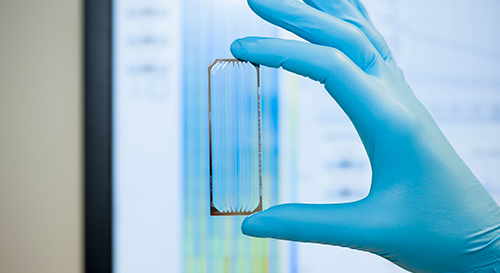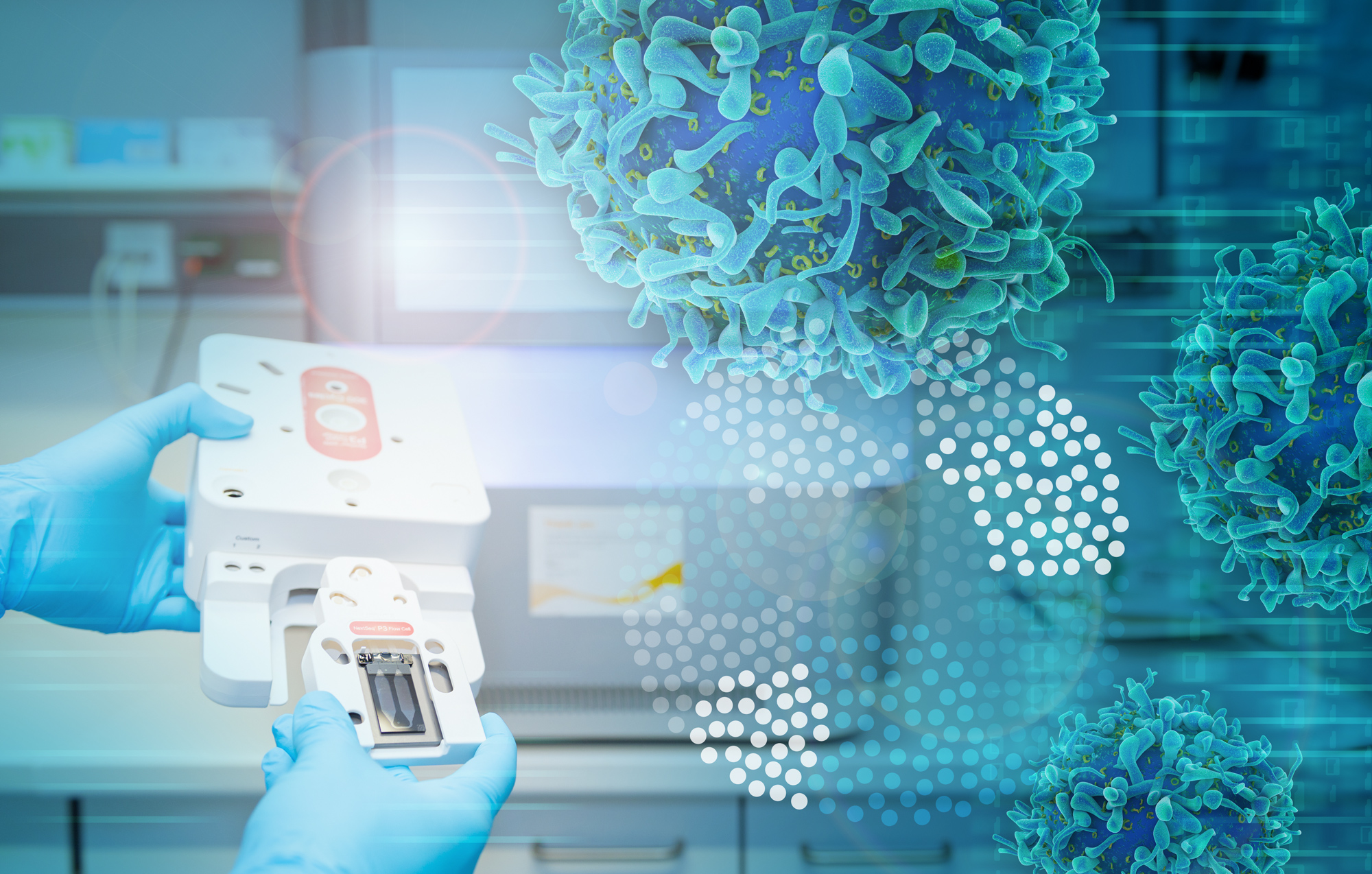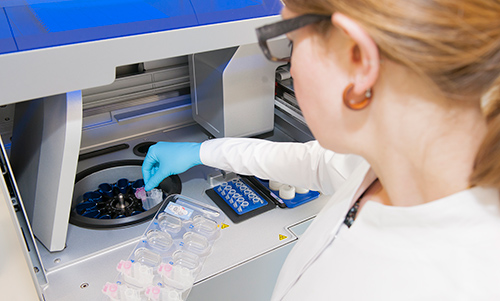Next-Generation Diagnostics
AI-CARs
Currently, every year, around 24,000 people in Germany are diagnosed with malignant melanoma, i.e. black skin cancer, an extremely aggressive tumour with high metastatic potential. In spite of modern treatment methods, the 10-year survival rate of patients in the metastasized stage is below 20 percent.
So far, considerable success has been achieved in treating malignant melanoma with antibodies (so-called immune checkpoint inhibitors) which inhibit the activity of tumour-masking proteins. This, in turn, reactivates the body’s immune response to the tumour. However, a majority of patients (60 percent) does not respond to these treatments and the recurrence rate is high.
The CAR-T cell treatment, which has already been established in haemato-oncological applications, now also provides new options for the treatment of solid tumours, such as malignant melanoma: For this treatment, the patients’ immune cells are equipped with a synthetic receptor which enables the immune cells to detect potential cancer cells and specifically eliminate them in future.
As part of the “AI-CARs” project, the partners first want to define new target structures for treating malignant melanoma using human tumour samples and to subsequently develop an effective CAR-T cell treatment during the pre-clinical phase.
To this end, Fraunhofer IZI will use state-of-the-art sequencing technologies (single cell sequencing and spatial sequencing) to define potential target structures first. This involves the collection of highly complex datasets reflecting the cells’ dynamic behaviour. In cooperation with Leipzig University, effective interacting molecule pairs and specific target structures will be identified from these data, e.g., using artificial intelligence methods and computer-assisted modelling.
The Helmholtz-Zentrum Dresden-Rossendorf will develop CAR-T cells specifically for these target structures on the basis of a RevCAR-T platform and then test these pre-clinically. Unlike conventional CAR-T cells, RevCAR-T cells cannot directly detect tumour cells. They need an additional tumour-specific target model. As a result, the activity of the RevCAR-T cells and, hence, side effects can be controlled via the target modules’ availability.
Partners
Leipzig University Hospital, Department of Dermatology, Venereology and Allergology; Leipzig University, Drug Development Department; Helmholtz Zentrum Dresden Rossendorf, Radio-Immunology Department

Completed projects

SARS-CoV-2 whole genome sequencing according to coronavirus surveillance regulation
The worldwide spread of SARS-CoV-2 (Severe acute respiratory syndrome coronavirus type 2) as well as new virus variants with putative increased risk of infection make a timely determination of the currently circulating virus strains necessary. With the aim to increase the number of SARS-CoV-2 genome sequencing in Germany and thus to detect the spread of the virus as well as the emergence of new variants at an early stage, the Coronavirus Surveillance Ordinance (CorSurV) came into force on 19 January 2021. This regulation requires that at least 5 % of all samples tested positive for SARS-CoV-2 must be sequenced (10 % if there are fewer than 70,000 new infections in a week nationwide). In addition, all sequencing data obtained must be transmitted to the RKI via the DESH platform and the findings must be reported to the ”Gesundheitsämter” in order to collect all data centrally.
To perform whole genome sequencing, an approach is used in which the complete viral genome is first amplified in sections, using specific PCR reactions. Subsequently, these genome sections are labeled with sample-specific barcodes as well as sequencing adapters. This allows multiple samples to be sequenced in parallel, i.e. the sequence of nucleic acid bases of each viral genome is determined. The resulting raw sequence data is subjected to bioinformatics analysis, in which the nucleic acid sequences of the individual genome segments are assigned to the corresponding samples and reassembled into a complete viral genome. Subsequently, the sequenced viral genome is aligned with the reference genome of the SARS-CoV-2 strain originally encountered in Wuhan. If relevant changes are detected compared to the reference genome, the new viral sequence is checked against a database to determine which viral variant it is. The results are compiled in a report and sent to the respective client (clinical partners or diagnostic laboratories), and the complete sequence data is transmitted electronically to the RKI.
Knowledge of the predominant virus variants, combined with information on the timing, frequency and location of occurrence, enables the determination of changes with regard to the speed of spread and severity of the disease caused and, if necessary, the initiation of appropriate measures by the relevant authorities.
Development of novel biomarkers to diagnose and predict prostate cancer
The changing demographic landscape is causing a steady rise in the number of oncological, chronic-inflammatory and degenerative diseases. Despite a similarly growing number of therapeutic options, treating these diseases often proves unsatisfactory. Personalized therapy can bring about fundamental progress here. For this to work, the molecular basis of a disease first needs to be precisely determined and the case-specific disease progression and response to therapy has to be predicted. Ever since the human genome was sequenced in full in 2001, the decoding of disease-relevant genes has opened up new options for developing tailor-made approaches to therapy. Alongside evidence of changes in DNA patterns (e.g. mutations), the investigation of RNA gene expression patterns by means of transcriptome-wide sequencing is increasingly shifting into focus.
As part of the RIBOLUTION project, funded by the Fraunhofer Future Foundation, new biomarkers were identified for prostate cancer based on transcriptome-wide (RNA) sequencing together with microarray analyses. Biomarkers were identified here that can diagnose the disease and also predict the aggressiveness of the cancer.
In order to validate and subsequently use these biomarkers for diagnostic purposes, a manageable number of biomarkers is to be identified using a simple test. To do this, a workflow for detecting diagnostic biomarkers in the urine, using quantitative real-time PCR (qPCR) was developed. For optimization purposes, suitable reference and target regions as well as primers and probes were tested in depth and the reaction conditions were adapted, among other things. For the assessment, the selected biomarkers were investigated in close cooperation with the Bioinformatics Unit using a specially developed algorithm.
For the more complicated issue of predicting the cancer, the Next-Generation Diagnostics Unit developed a workflow based on RNA sequencing from FFPE biopsy material. The aim here was to identify a broad spectrum of potential biomarkers in clinically available samples. In the interests of reducing time and costs, sequencing was optimized in terms of sensitivity and robustness. Based on this established method, the transcriptome-wide sequencing of a large patient cohort (n>150) is currently being carried out to validate the identified biomarkers.
The workflows developed in this project are to be transferred to other indications in the future.
RIBOLUTION
The "RIBOLUTION – integrated platform for the identification and validation of innovative RNA-based biomarkers for personalized medicine" project is a research association supported by the “Fraunhofer-Zukunftsstiftung” (Fraunhofer Future Foundation). The project is coordinated by Prof. Dr. Friedemann Horn at Fraunhofer IZI.
New RNA biomarkers for complex disorders (e.g. oncological, chronic-inflammatory and degenerative disorders) are being identified in the RIBOLUTION project by genome-wide screening processes. RIBOLUTION also includes so-called non-coding RNAs whose significance as potential biological markers have only been investigated in the recent past. Additionally, the process of the biological marker screening by RIBOLUTION is optimized and perfected with the help of technical innovations.
Subsequent to the screening phase, potential biomarkers are evaluated with regard to their diagnostic and prognostic significance. Biomarkers with the ability to indicate a disorder or its course or forecast the response to therapies are of special interest.

